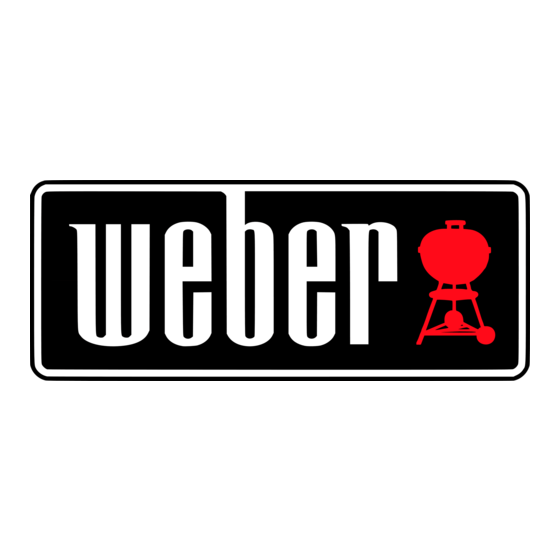Table of Contents
Advertisement
BUILT-IN GAS BARBECUE
E-360 • S-360
E-460 • S-460
Installation Guide
REGISTER TODAY
We are so glad that you have joined us on the journey to barbecuing greatness.
Register your barbecue and gain access to fun and engaging WEBER information,
including tips, tricks and how to get the most out of your barbecuing experience.
Keep this Owner's Manual for future reference, thoroughly read through it, and
if you have any questions please contact us today.
ULPG
30763
041223
AUNZ
Advertisement
Table of Contents

Summary of Contents for Weber Genesis E-360
- Page 1 We are so glad that you have joined us on the journey to barbecuing greatness. Register your barbecue and gain access to fun and engaging WEBER information, including tips, tricks and how to get the most out of your barbecuing experience.
-
Page 2: Important Safety Information
Important Installation and Assembly Storage and/or Nonuse DANGER: This barbecue is not intended to be WARNING: Turn off the gas supply at the gas cylinder Safety Information installed in or on recreational vehicles or boats. after use. WARNING: Do not use this barbecue unless all WARNING: LPG cylinders must be stored outdoors DANGER, WARNING, and CAUTION parts are in place and the barbecue was properly... -
Page 3: Considerations For Locating Your Barbecue
Considerations for Locating your Barbecue Any enclosure in which the appliance is used shall comply with one of the following: • An enclosure with walls on all sides, but at least one permanent opening at ground level and no overhead cover (A). •... -
Page 4: Configuration Options
Configuration Options “ISLAND” STRUCTURE CONFIGURATION OPTIONS Recommended Gas Supply Locations There are several configuration options for the grill and gas supply access of your Island structure. The 3 common options (A, B, C) are illustrated in the ‘Island’ Structure Configuration Options” table. If there are local codes that apply to “built-in”... -
Page 5: General Construction
General Construction The GENESIS Built-In unit should be on site before construction begins. For ease of installation, the barbecue will be pushed on its casters into the built-in structure. The installation of this barbecue requires a level floor pad surface (1) and countertop surface. The floor pad surface must be constructed from solid materials and must be level and smooth. - Page 6 Positioning Your Barbecue CLEARANCES FROM COMBUSTIBLE MATERIALS When determining a suitable location for your barbecue installation, give thought to concerns such as exposure to wind, proximity to traffic paths, and keeping any gas supply lines as short as possible. Never locate the barbecue in a garage, breezeway, or shed, under an unprotected overhang, or in any other enclosed area.
- Page 7 Planning the LPG Cylinder Enclosure Typical LPG Gas Supply Installation The LPG cylinder enclosure shall house the included hose and regulator assembly. The hose and regulator are required parts of the built-in gas barbecue. A properly constructed cylinder enclosure meets the requirements for venting and separation of the LPG cylinder from a heat source.
- Page 8 LPG Cylinder Enclosure Clearances From CLEARANCES - LPG CYLINDER Surfaces or Structures When determining a suitable location for your LPG cylinder enclosure, give thought to concerns such as proximity to traffic paths and keeping any gas supply lines as short as possible. Never install the LPG cylinder enclosure in a garage, breezeway, or shed, under an unprotected overhang, or in any other enclosed area.
-
Page 9: General Specifications For Piping
Built-In Gas Line Location BUILT-IN GAS LINE LOCATION A 58 inch (147 cm) main corrugated gas line is connected to the manifold of the barbecue. Build an opening for the corrugated gas line to pass through to the LPG cylinder enclosure, where connections to the bulkhead, hose and regulator will be made. - Page 10 BUILT-IN CUTOUT DETAILED DIMENSIONS - LOCATING THE STRUCTURE NEAR A COMBUSTIBLE WALL 24" (610 mm) minimum* 24" (610 mm) minimum* Minimum from cutout edge to combustible construction. Minimum from cutout edge to combustible construction. 0" (0 mm) minimum** 0" (0 mm) minimum** 12"...
- Page 11 BUILT-IN CUTOUT DETAILED DIMENSIONS - LOCATING THE STRUCTURE NEAR A NONCOMBUSTIBLE WALL 24" (610 mm) minimum* 24" (610 mm) minimum* Minimum from cutout edge to combustible construction. Minimum from cutout edge to combustible construction. 0" (0 mm) minimum 0" (0 mm) minimum 12"...
















Need help?
Do you have a question about the Genesis E-360 and is the answer not in the manual?
Questions and answers